Omnichannel customer support and its role in modern business
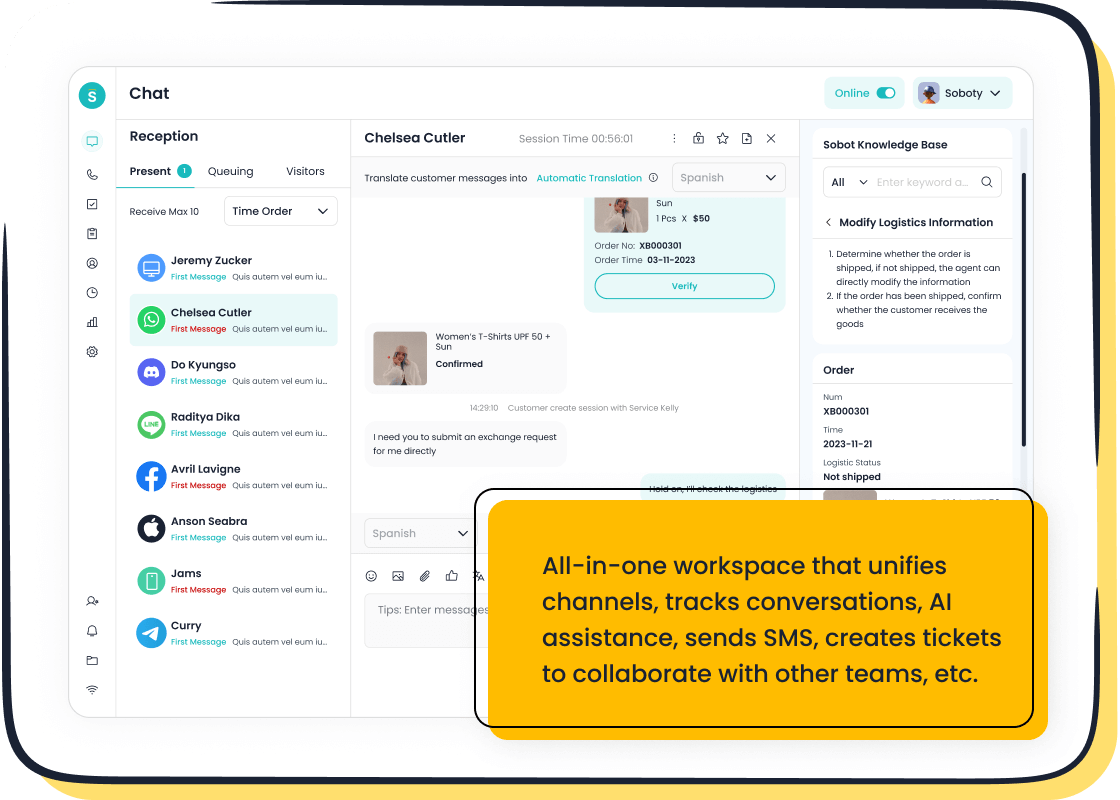
Omnichannel customer support provides a seamless way for you to interact with customers across multiple platforms. It ensures consistency in service, whether customers reach out through social media, live chat, or in-store visits. This approach meets the expectations of 75% of consumers who demand consistent experiences across all channels. It also personalizes interactions, which drives customer satisfaction and boosts spending by 13%. As customer preferences evolve in 2025, businesses that adopt omnichannel strategies will stay ahead. Tools like Sobot’s solutions ensure your service remains efficient and connected, enhancing customer loyalty and satisfaction.
What is omnichannel customer support?
Omnichannel customer support is a modern approach to delivering seamless and integrated customer service. It ensures that customers can interact with your business across multiple platforms without losing context or consistency. This strategy connects all communication channels, creating a unified experience that meets the expectations of today’s digital-savvy customers.
Definition and key characteristics
Omnichannel customer support focuses on providing a consistent and personalized experience across all touchpoints. Here are its key characteristics:
- Unified communication: Conversations and data are synchronized across channels, ensuring that customers don’t need to repeat themselves.
- Integrated data management: Teams can access customer information in real-time, enabling efficient and personalized service.
- Seamless transitions: Customers can switch between channels, such as live chat and email, without disrupting the flow of their interaction.
For example, Sobot’s omnichannel solution consolidates customer interactions from platforms like WhatsApp, Facebook, and email into a single workspace. This integration allows your team to deliver timely and accurate support, enhancing the overall customer experience.
Differences between omnichannel and multichannel support
While both omnichannel and multichannel approaches involve multiple communication channels, their execution differs significantly. The table below highlights these differences:
| Feature | Omnichannel Support | Multichannel Support |
|---|---|---|
| Customer Experience | Unified and personalized across all channels | Disjointed due to siloed data and separate management |
| Data Management | Integrated data for a comprehensive view of customer | Separate data for each channel, leading to silos |
| Customer Journey | Seamless transitions between channels | Independent interactions on each channel |
| Engagement Metrics | 360-degree relationship metrics for proactive engagement | Channel-specific metrics limiting comprehensive view |
Brands with strong omnichannel engagement report a 9.5% annual revenue increase, compared to just 3.4% for those with weaker strategies. This demonstrates the value of adopting a unified approach to customer support.
Why consistency across channels matters for customer satisfaction
Consistency is crucial for building trust and loyalty. Studies show that 90% of customers expect uniform interactions across all channels. When support is consistent, customers feel valued and understood, which enhances their overall experience. On the other hand, a single negative interaction can drive 52% of customers to switch to a competitor.
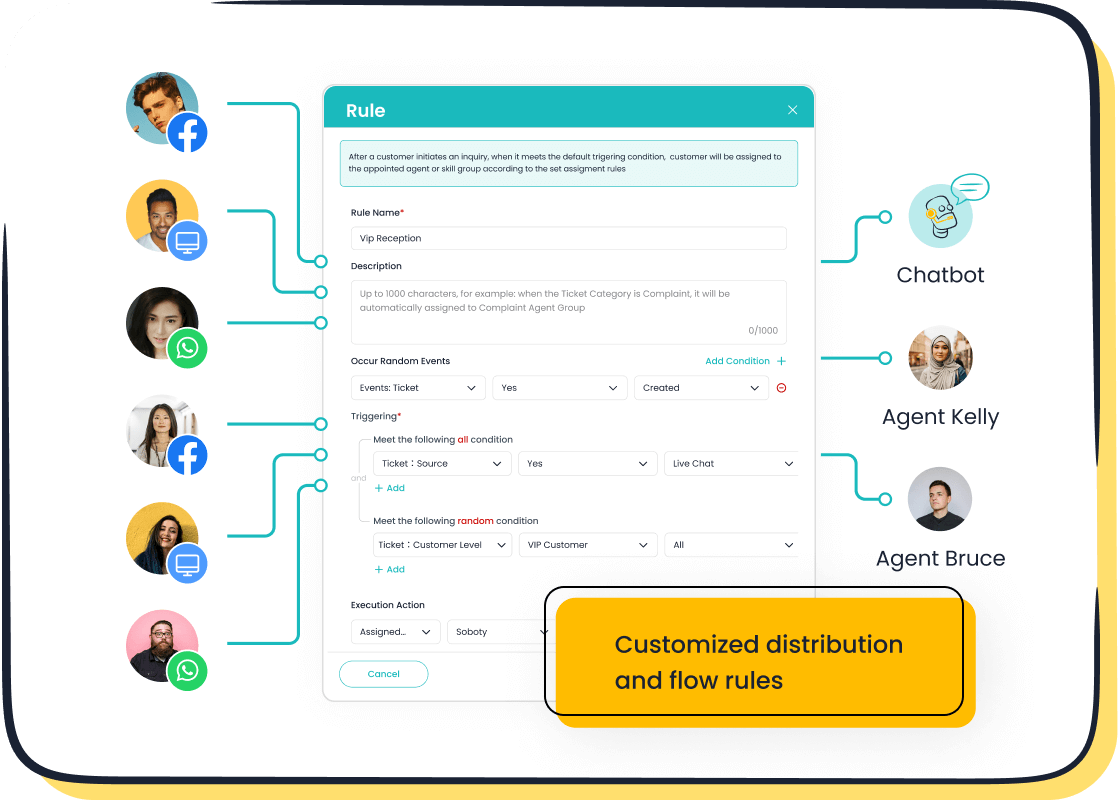
Omnichannel customer service ensures that your team delivers reliable and coherent communication. For instance, Sobot’s Live Chat tool keeps all conversations in one place, enabling agents to provide timely and accurate assistance. This streamlined approach not only improves satisfaction but also increases the likelihood of customer recommendations.
Tip: Consistent support across channels doesn’t just improve satisfaction—it also boosts loyalty and retention, driving long-term business growth.
The importance of omnichannel customer support in 2025
Meeting customer expectations in a digital-first world
In 2025, customers expect businesses to meet them where they are—whether on social media, email, or live chat. The rise of digital-first interactions has made omnichannel essential for delivering seamless customer service. Customers no longer tolerate fragmented experiences. They want their journey to flow smoothly across platforms without repeating themselves.

Omnichannel strategies address these expectations by integrating communication channels into a unified system. For instance, Sobot’s omnichannel solution allows you to manage customer interactions from platforms like WhatsApp, Facebook, and email in one workspace. This ensures that your team can provide consistent and efficient service, no matter where the conversation starts.
Research highlights the importance of meeting these expectations:
- Omnichannel customers spend 10% more online than single-channel customers.
- Brand loyalty improves by up to 90% when customers engage consistently across channels.
- Integrated approaches lead to 30% higher conversion rates compared to single-channel operations.
By adopting an omnichannel strategy, you can not only meet but exceed customer expectations in this digital-first era.
The role of omnichannel in enhancing customer loyalty
Customer loyalty is the backbone of long-term business success. Inconsistent service across channels can erode trust and push customers toward competitors. Omnichannel customer service plays a pivotal role in fostering loyalty by ensuring that every interaction feels personalized and reliable.
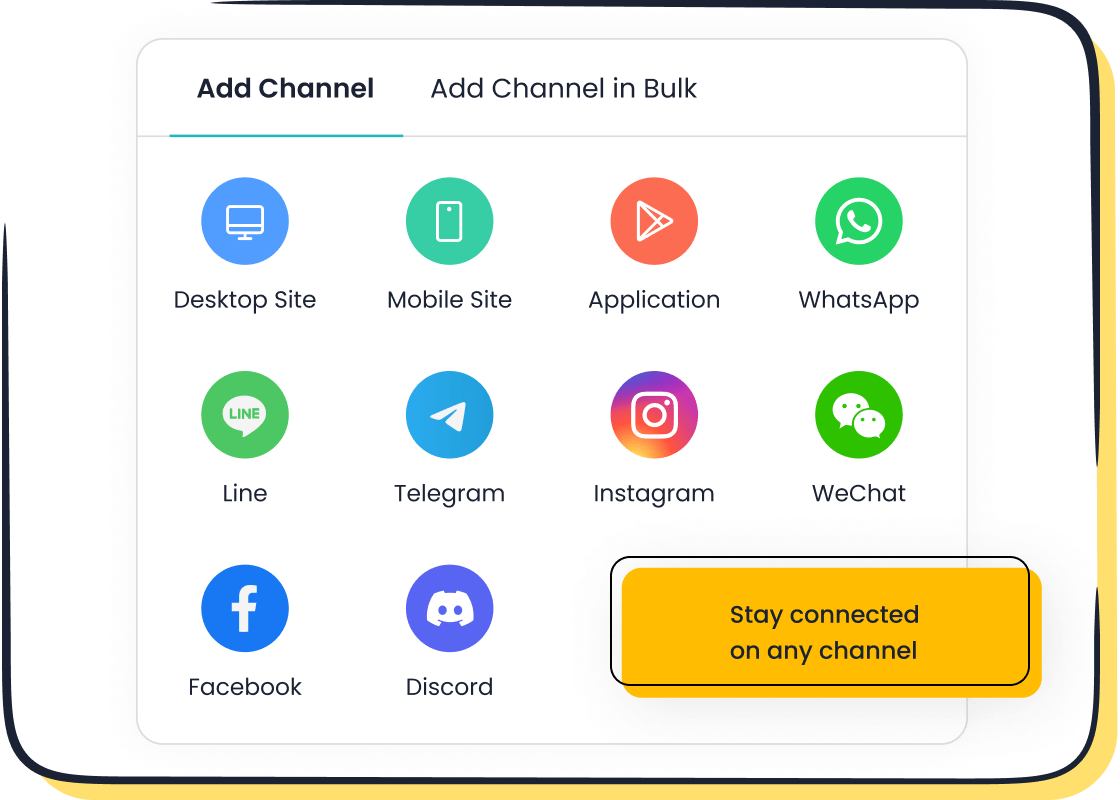
When customers feel valued and understood, they are more likely to return. For example, Sobot’s Live Chat tool consolidates conversations into a single view, enabling your agents to provide timely and accurate responses. This level of consistency builds trust and strengthens relationships.
Data supports this connection between omnichannel and loyalty. According to the Aberdeen Group, brands that deliver consistent experiences across channels see a 90% improvement in customer loyalty. By investing in omnichannel solutions, you can create a loyal customer base that drives repeat business and positive word-of-mouth.
Why businesses must prioritize omnichannel strategies to stay competitive
The global market for omnichannel customer support is projected to grow significantly, reaching $10.13 billion by 2025 with a compound annual growth rate (CAGR) of 14%. By 2032, this figure is expected to soar to $25.35 billion. This growth underscores the increasing importance of omnichannel strategies in staying competitive.
| Year | Market Size (USD) | CAGR (%) |
|---|---|---|
| 2025 | 10.13 Billion | 14% |
| 2032 | 25.35 Billion | N/A |
Businesses that fail to adapt risk falling behind. Customers now demand seamless transitions between channels and personalized interactions. Companies that prioritize omnichannel strategies gain a competitive edge by delivering superior customer experiences.
Sobot’s omnichannel solution equips you with tools to meet these demands. Features like AI-driven chatbots and unified workspaces streamline operations and enhance customer satisfaction. By adopting such solutions, you position your business for success in the future, ensuring you remain relevant in an increasingly competitive landscape.
Benefits of omnichannel customer support

Enhanced customer experience and satisfaction
Omnichannel customer support transforms how customers interact with your business. It ensures a seamless experience by connecting all communication channels, making customers feel valued and understood. This approach enhances customer satisfaction and fosters loyalty. For instance, customers who experience consistent service across platforms are more likely to trust your brand and return for future interactions.
Businesses that invest in an omnichannel strategy see remarkable results:
- Companies adopting the omnichannel experience have grown from 20% to over 80%.
- Strong omnichannel engagement strategies lead to a 10% year-over-year growth.
- Close rates improve by 25%, and average order values increase by 10%.
These statistics highlight how an effective omnichannel experience not only improves customer satisfaction but also drives business growth.
Improved efficiency and reduced response times
Omnichannel customer service streamlines operations, enabling your team to respond faster and more effectively. By integrating all communication channels into a unified system, agents can access customer information instantly, reducing the time spent switching between platforms. This efficiency ensures that customers receive timely support, which is critical in today’s fast-paced world.
Consider these metrics:
| Metric | Value |
|--------|-------|
| Percentage of agents finding it tricky to balance service speed and quality | 69% |
| Customers citing long wait times as frustrating | 60% |
| Customers expecting a response faster than four hours | 46% |
By adopting an omnichannel approach, you can address these challenges. Tools like Sobot’s omnichannel solution help agents manage inquiries efficiently, ensuring faster response times and higher customer satisfaction.
Better data insights for personalized interactions
Omnichannel customer support provides valuable data insights that enable personalization. By consolidating customer interactions into a single platform, your team gains a comprehensive view of each customer’s journey. This data allows you to tailor your service to meet individual needs, creating a personalized experience that resonates with customers.
Regularly analyzing customer satisfaction scores and agent performance metrics can help identify areas for improvement. This proactive approach ensures that your omnichannel strategy evolves to meet changing customer expectations. Personalization not only enhances the customer experience but also strengthens loyalty, ensuring long-term success for your business.
Tip: Use tools like Sobot’s Live Chat to gather real-time data and deliver personalized experiences that delight your customers.
Increased customer retention and lifetime value
Retaining customers is more cost-effective than acquiring new ones. Omnichannel customer support plays a vital role in increasing customer retention and lifetime value. By delivering consistent and personalized experiences, you can build trust and loyalty, encouraging customers to stay with your brand longer.
When customers feel valued, they are more likely to return. Omnichannel strategies ensure that every interaction meets their expectations. For example, Sobot’s omnichannel solution consolidates communication channels into one platform. This allows your team to provide seamless support, whether customers reach out via email, social media, or live chat. Such efficiency fosters satisfaction and strengthens relationships.
Data shows that loyal customers spend more over time. They also recommend your business to others, amplifying your growth. A study by Bain & Company reveals that increasing customer retention by just 5% can boost profits by 25% to 95%. Omnichannel support helps you achieve this by addressing customer needs promptly and effectively.
Personalized interactions further enhance retention. With tools like Sobot’s Live Chat, your team can access customer data in real-time. This enables tailored responses that resonate with individual preferences. Customers appreciate this level of attention, which deepens their connection to your brand.
Tip: Focus on creating memorable experiences for your customers. Happy customers not only stay longer but also contribute to your business’s long-term success.
By adopting an omnichannel approach, you can maximize customer lifetime value. This strategy ensures that your customers remain loyal, satisfied, and engaged, driving sustainable growth for your business.
How to implement omnichannel customer support effectively
Identifying and integrating essential communication channels
To implement an effective omnichannel strategy, you must first identify the communication channels your customers prefer. These may include email, social media, live chat, or even in-store interactions. Once identified, integrating these channels into a unified system ensures a seamless experience for your customers.

A successful integration strategy requires the right technology. For example, Sobot’s omnichannel solution consolidates platforms like WhatsApp, Facebook, and email into a single workspace. This integration allows your team to manage interactions efficiently, ensuring consistent and personalized customer service.
The importance of channel integration is evident in industry benchmarks:
| Statistic Description | Value |
|---|---|
| Businesses finding Omnichannel crucial | 87% |
| Customer retention boost from Omnichannel strategies | 89% |
| Increase in purchase rates due to Omnichannel | 287% |
These figures highlight how integrating essential channels can significantly enhance customer satisfaction and retention.
Leveraging tools like Sobot Live Chat for seamless interactions

The right tools play a critical role in delivering omnichannel customer support. Sobot Live Chat is an excellent example of a platform designed to provide a seamless experience. It supports multiple channels, including websites, apps, and social media platforms like Instagram and Telegram.
With features like AI-assisted tools, real-time analytics, and customer segmentation, Sobot Live Chat enables your team to deliver personalized and efficient support. For instance, its unified workspace ensures that agents can access all customer interactions in one place, reducing response times and improving service quality.
Businesses that adopt tools like Sobot Live Chat often see measurable improvements. For example, omnichannel customers shop 1.7 times more frequently than single-channel shoppers. Additionally, companies like Zara have reported a 74% increase in online sales after adopting an omnichannel approach. These results demonstrate the value of leveraging advanced tools to enhance customer interactions.
Training teams for cross-channel consistency
Your team’s ability to deliver consistent service across channels is vital for the success of your omnichannel strategy. Training programs should focus on familiarizing agents with the integrated system and teaching them how to maintain a unified tone and approach across all platforms.
For example, Sobot’s omnichannel solution provides a unified workspace that simplifies agent workflows. Training your team to use such tools effectively ensures they can handle customer inquiries seamlessly, regardless of the channel.
Consistency builds trust and loyalty. Studies show that 90% of customers expect uniform interactions across all channels. By equipping your team with the right skills and tools, you can meet these expectations and create a positive customer experience that drives long-term success.
Measuring success with key performance indicators (KPIs)
Tracking the success of your omnichannel strategy requires clear and measurable goals. Key performance indicators (KPIs) help you evaluate how well your approach meets customer expectations and drives business growth. By focusing on the right metrics, you can identify strengths, uncover areas for improvement, and optimize your strategy for better results.
Types of KPIs to Measure Omnichannel Success
Different KPIs provide insights into various aspects of your operations. Here’s a breakdown of the most reliable indicators:
| KPI Type | Examples |
|---|---|
| Customer Satisfaction | Net-Promoter Score, Customer Satisfaction Score, Advocacy, Loyalty |
| Brand Recall | Improved brand recall compared to competitor brands |
| Service/Support Feedback | Enhanced feedback across cross-channel interactions |
| Sales Operations Profile | Activity Metrics, Channel Metrics, Geography Metrics |
| Marketing Operations Profile | Campaign Metrics, Channel Metrics, Content Metrics |
| Service Operations Profile | Case Metrics, Channel Metrics, Support Metrics |
| Campaign Effectiveness | Cross-channel Campaigns, Campaign Optimization, Triggered Campaigns |
| Journey Deployment | Persona-based Executions, Journey Optimization |
| Program ROI | Program Goal Attainment, Program Engagement, Program Impact (Lift/ROI) |
These KPIs provide a comprehensive view of your omnichannel strategy’s performance, helping you align your efforts with customer needs and business objectives.
Essential Metrics to Track
Certain metrics stand out for their ability to measure the effectiveness of omnichannel strategies. Consider focusing on these:
- Engagement Score: This metric evaluates the quality of customer interactions across channels. Higher engagement indicates that your strategy resonates with your audience.
- Loyalty Score: Tracking loyalty helps you understand how many customers consistently choose your brand over competitors.
- Net Promoter Score (NPS): NPS measures customer satisfaction and loyalty. It reveals how likely customers are to recommend your brand, highlighting areas for improvement.
Tip: Regularly monitor these metrics to ensure your strategy adapts to changing customer expectations. Tools like Sobot’s omnichannel solution can simplify data collection and analysis, enabling you to make informed decisions.
By leveraging KPIs effectively, you can refine your omnichannel approach, enhance customer satisfaction, and drive long-term business success.
Practical applications of omnichannel customer support
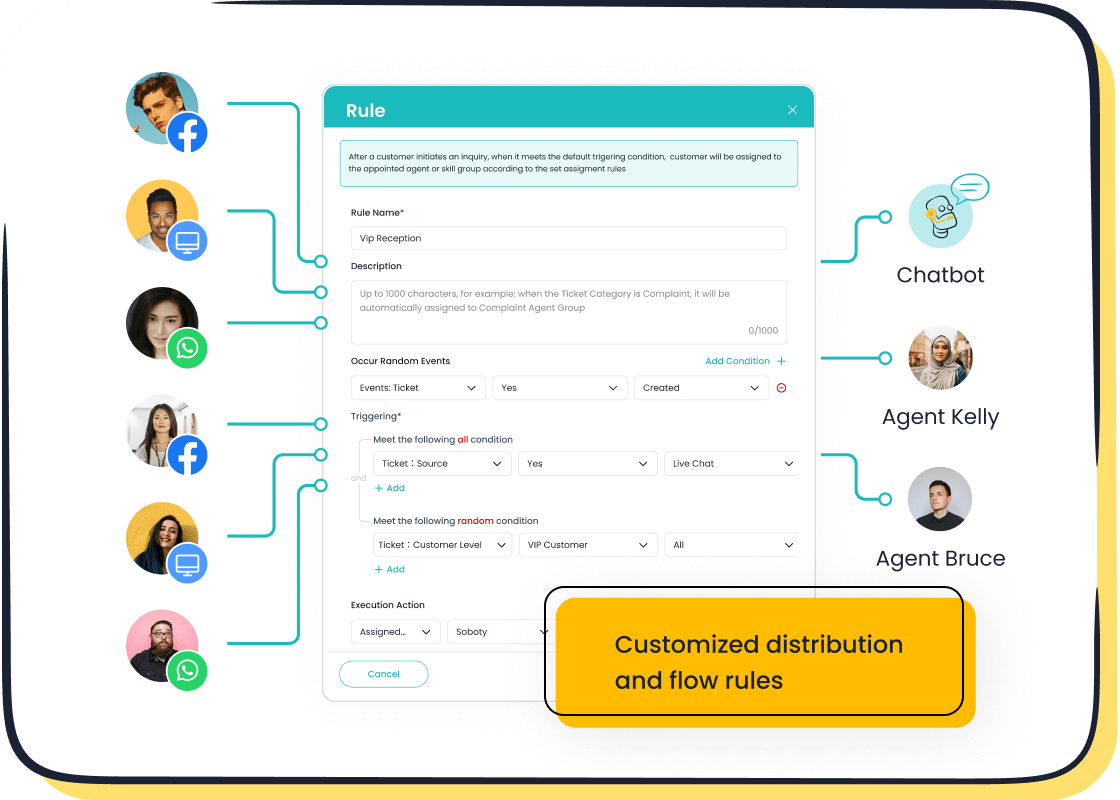
Retail: Unified online and in-store experiences
In retail, omnichannel customer support bridges the gap between online and in-store shopping. Customers expect a seamless journey, whether browsing products online or visiting a physical store. For example, they might research an item on your website, check its availability through live chat, and then pick it up in-store. By unifying these touchpoints, you ensure a consistent experience that meets their expectations.
Omnichannel strategies also enhance personalization. Tools like Sobot’s omnichannel solution allow you to track customer preferences and purchase history. This data enables you to offer tailored recommendations, boosting satisfaction and loyalty. Retailers adopting this approach often see higher conversion rates and improved customer retention.
E-commerce: Seamless support across chat, email, and social media
E-commerce thrives on efficient and responsive customer service. Integrating chat, email, and social media into a unified system ensures that customers receive consistent support, no matter how they reach out. For instance, a customer might inquire about a product on Instagram, follow up via email, and complete the purchase through live chat. An omnichannel experience ensures that all these interactions flow smoothly.
Performance metrics validate the effectiveness of this integration:
| Metric | Description |
|---|---|
| Customer Satisfaction Score | Measures how satisfied customers are after using the service, typically on a scale of 1 to 5. |
| Average Complaint Resolution Time | Indicates the average time taken to resolve customer complaints, with lower times being better. |
| Average Resolution Time | Total time taken to resolve inquiries divided by total inquiries, aiming for lower values. |
| Escalation Rate | Measures how often customers request to speak with a supervisor, with lower rates being preferable. |
| Customer Service Chat Count | Indicates how often customers initiate chats, with lower counts suggesting fewer issues. |
| Active Queries | Number of unresolved customer tickets, aiming for zero by the end of the week. |
By leveraging tools like Sobot Live Chat, you can streamline these processes, ensuring faster resolutions and higher satisfaction.
Financial services: Personalized banking experiences
In financial services, customers demand tailored and simplified experiences. Omnichannel support allows you to meet these expectations by integrating communication channels like mobile apps, email, and chat. For example, a customer might start a loan inquiry on your website, receive updates via email, and finalize the process through a mobile app. This cohesive approach enhances trust and satisfaction.
Personalization plays a key role in this sector. Studies show that 70% of customers prefer personalized banking experiences, and 60% of Gen Zers report improved financial habits due to digital banking services. Tools like Sobot’s omnichannel solution enable you to analyze customer data and offer tailored financial advice or promotions. This not only improves their experience but also strengthens loyalty.
Note: A strong omnichannel customer experience is essential for building trust and retaining customers in competitive industries like financial services.
How Sobot’s Omnichannel Solution supports diverse industries
Sobot’s Omnichannel Solution empowers businesses across industries to deliver exceptional customer experiences. By unifying communication channels, it ensures seamless interactions that meet the unique needs of each sector. Whether you operate in retail, financial services, or gaming, Sobot’s tools help you enhance customer satisfaction and streamline operations.
Real-world impact: Samsung’s success story
Sobot’s solution has proven its effectiveness with global brands like Samsung. The integration of Sobot’s omnichannel platform helped Samsung achieve a 97% Customer Satisfaction Score (CSAT) and a 30% increase in agent efficiency. These results highlight how Sobot’s tools optimize customer service while boosting productivity.
| Company | Customer Satisfaction Score (CSAT) | Increase in Agent Efficiency |
|---|---|---|
| Samsung | 97% | 30% |
Retail: Personalized shopping experiences
In retail, customers expect personalized and consistent service. Sobot’s omnichannel platform allows you to track customer preferences and purchase history. This data enables tailored recommendations, improving satisfaction and driving repeat purchases. For example, integrating live chat and social media ensures customers receive support wherever they shop.
Financial services: Simplified customer interactions
Financial services require secure and efficient communication. Sobot’s solution integrates channels like email, mobile apps, and chat into one system. This approach simplifies complex inquiries, ensuring customers receive timely and accurate assistance. Personalized interactions build trust, which is essential in this industry.
Gaming: Faster issue resolution
In gaming, players demand quick resolutions to technical issues. Sobot’s AI-driven tools and unified workspace enable support teams to respond faster. By consolidating data, agents can address problems efficiently, enhancing the player experience and fostering loyalty.
Sobot’s Omnichannel Solution adapts to the needs of diverse industries, helping businesses deliver consistent and personalized customer support. By leveraging its tools, you can improve satisfaction, boost efficiency, and stay ahead in a competitive market.
Challenges and solutions in omnichannel customer support
Common challenges: Integration, data silos, and resource allocation
Implementing omnichannel customer support comes with its own set of challenges. Integration issues often arise when connecting multiple communication platforms. Agents may struggle to access a customer’s history across channels, leading to fragmented interactions. Siloed data repositories further complicate matters by preventing teams from sharing critical information. This lack of integration can erode the customer experience and hinder personalization.
Resource allocation is another hurdle. Managing multiple channels requires significant time and effort. Incompatible workflows between departments can disrupt the flow of service, making it harder to deliver consistent support. These challenges highlight the need for a well-planned omnichannel strategy to ensure seamless operations.
Solutions: Investing in technology and fostering collaboration
Overcoming these challenges requires strategic investments in technology. Modular software solutions and integration tools can streamline data exchange, ensuring agents have real-time access to customer information. Platforms like Sobot’s omnichannel solution consolidate communication channels into a unified workspace, simplifying workflows and enhancing efficiency.
Adopting agile development methodologies can also help. Breaking projects into manageable phases and incorporating user feedback ensures that your system evolves to meet customer needs. Regularly researching emerging technologies keeps your business ahead of the curve.
Collaboration between teams is equally important. Encouraging departments to share insights and align their workflows fosters a cohesive approach to customer service. Clear milestones and regular status meetings can improve coordination, ensuring your team delivers consistent support across all channels.
The importance of continuous improvement and feedback
Continuous improvement is essential for maintaining effective omnichannel customer service. Regularly gathering feedback from customers helps you identify pain points and refine your approach. Studies show that businesses adapting quickly to customer needs build stronger relationships and improve loyalty.
Tracking key metrics like customer satisfaction scores and engagement rates provides valuable insights into your performance. For example, brands with strong omnichannel engagement report a 9.5% annual revenue increase. By analyzing this data, you can make informed decisions to enhance the customer experience.
Personalized experiences also play a crucial role. Research indicates that 80% of consumers are more likely to make a purchase when they receive tailored interactions. Tools like Sobot’s Live Chat enable you to gather real-time data, ensuring your service remains relevant and effective.
Tip: Treat feedback as an opportunity to grow. Regularly update your omnichannel strategy to meet evolving customer expectations and stay competitive.
The future of omnichannel customer support
Emerging trends: AI, automation, and predictive analytics
The future of omnichannel customer support is shaped by advancements in AI, automation, and predictive analytics. These technologies enhance how you deliver seamless and personalized service to customers. For example, advanced IVR systems streamline call handling, reducing wait times and improving satisfaction. AI-driven speech analytics provide actionable insights by analyzing customer interactions, helping your team improve service quality. Adaptive omnichannel routing ensures customers connect with the right agent, creating faster resolutions and better experiences.
Predictive analytics plays a vital role in proactive customer engagement. It anticipates customer needs, allowing you to address issues before they arise. Research shows that 71% of customers appreciate proactive outreach, and 70% view brands more favorably when contacted proactively. By adopting these trends, you can meet customer expectations for seamless conversations across channels and build stronger relationships.
| Trend | Description | Importance |
|---|---|---|
| Advanced IVR Systems | Streamlines inbound call handling, reducing wait times and improving service. | Can lead to a fivefold improvement in CSAT scores and reduce calls for human agents by over 10%. |
| AI-driven Speech Analytics | Analyzes customer interactions for actionable insights. | Supports agent performance, ensures compliance, and improves service quality. |
| Adaptive Omnichannel Routing | Matches customers with the right agent across channels. | Meets customer expectations for seamless experiences and improves resolution speed. |
| Proactive Customer Engagement | Uses predictive analytics to anticipate customer needs. | 71% of customers want proactive outreach, increasing satisfaction and loyalty. |
The role of omnichannel in building customer trust and loyalty
Omnichannel strategies play a critical role in fostering trust and loyalty. Customers value consistent and personalized experiences across all channels. When you deliver this, you create a cohesive brand experience that strengthens connections. Studies from Rengage and NICE highlight how omnichannel approaches enhance loyalty by meeting customer expectations and reducing pain points.
For example, Sobot’s omnichannel solution integrates communication channels into a unified workspace. This ensures your team can provide seamless support, whether customers reach out via email, live chat, or social media. By addressing customer needs promptly and efficiently, you build trust and encourage repeat business. A cohesive strategy not only improves satisfaction but also increases lifetime customer value.
| Evidence Source | Key Insight |
|---|---|
| Rengage | An effective omnichannel strategy fosters greater customer loyalty by creating a cohesive brand experience. |
| Nextiva | An omnichannel approach can foster stronger connections with loyal customers by meeting expectations and limiting pain points. |
| NICE | An omnichannel approach enhances customer loyalty by providing a seamless, personalized experience across all channels. |
How Sobot is shaping the future of omnichannel customer service
Sobot is at the forefront of shaping the future of omnichannel customer service. Its solutions leverage AI to deliver hyper-personalized experiences, enhancing customer engagement and satisfaction. For instance, AI-powered chatbots handle repetitive queries, freeing agents to focus on complex issues. This combination of AI and human agents ensures a superior customer experience across all touchpoints.
Sobot’s tools also analyze omnichannel data to predict customer needs. This leads to faster resolutions and increased revenue. By integrating platforms like WhatsApp, Facebook, and email into a unified workspace, Sobot enables your team to provide consistent and efficient support. These innovations position Sobot as a leader in the evolving landscape of customer service.
| Insight | Description |
|---|---|
| AI-Powered Personalization | AI enables businesses to deliver hyper-personalized experiences, enhancing customer engagement and satisfaction. |
| NICE Report Findings | AI analyzes omnichannel data to predict customer needs, leading to faster resolutions and increased revenue. |
| Integration of AI and Human Agents | The combination of AI chatbots and human agents across all touchpoints enhances the overall customer experience. |
Tip: Embrace tools like Sobot’s omnichannel solution to stay ahead in delivering exceptional customer service. These innovations ensure your business remains competitive in the future.
Omnichannel customer support has become a cornerstone of modern business success. It ensures seamless interactions across platforms, meeting the expectations of 75% of consumers who demand consistent experiences. By integrating communication channels, businesses can enhance customer satisfaction, foster loyalty, and drive growth. For instance, omnichannel strategies increase purchase rates by 250% compared to single-channel approaches.
Adapting to future trends is essential. The rise of mobile-first commerce and the growing demand for hyper-personalization highlight the need for seamless integration. Over 90% of shoppers now engage in omnichannel shopping, showcasing its importance in today’s market. Businesses that embrace these strategies will remain competitive and deliver exceptional customer experiences.
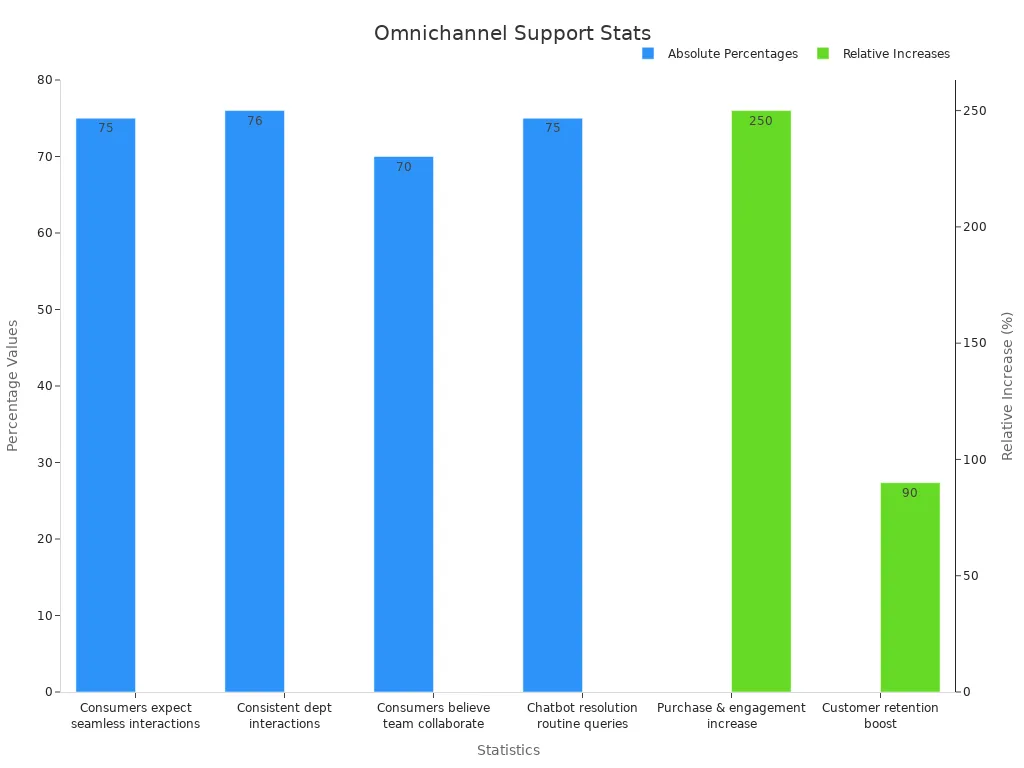
Note: Omnichannel solutions like Sobot’s empower businesses to meet evolving customer expectations, ensuring long-term success in a competitive landscape.
FAQ
What is the difference between omnichannel and multichannel customer support?
Omnichannel support connects all communication channels into one seamless system. Multichannel support uses separate platforms for each channel, creating disconnected experiences. Omnichannel ensures consistency and personalization, while multichannel often leads to fragmented interactions.
Tip: Choose omnichannel to provide a unified and satisfying customer experience.
How does Sobot’s Live Chat improve customer satisfaction?
Sobot’s Live Chat consolidates all conversations into one workspace. This allows your team to respond quickly and accurately. Features like AI assistance and real-time analytics ensure personalized service, which boosts customer satisfaction.
Emoji Insight: 💬 Faster responses = Happier customers!
Why is omnichannel customer support important for business growth?
Omnichannel strategies improve customer retention, loyalty, and satisfaction. They also increase conversion rates and revenue. By meeting customer expectations for seamless interactions, you build trust and encourage repeat business.
Fact: Businesses with strong omnichannel engagement see a 9.5% annual revenue increase.
Can Sobot’s solutions integrate with existing systems?
Yes, Sobot’s solutions integrate with platforms like Salesforce and Shopify. This ensures your team can access customer data across systems, improving efficiency and service quality.
Note: Integration simplifies workflows and enhances productivity.
How do I measure the success of my omnichannel strategy?
Track key performance indicators (KPIs) like customer satisfaction scores, response times, and retention rates. Use tools like Sobot’s analytics to gather insights and refine your approach.
| KPI Example | Purpose |
|---|---|
| Net Promoter Score | Measures customer loyalty |
| Average Response Time | Tracks service efficiency |
Pro Tip: Regularly review metrics to adapt to customer needs.
See Also
Comprehensive Overview of Omnichannel Call Center Tools
Ten Key Steps for Adopting Omnichannel Contact Solutions
AI-Driven Customer Support Agents Transform Service Experience
Round-the-Clock Live Chat Enhances Business Performance
Essential QMS Principles for Effective Call Center Management
